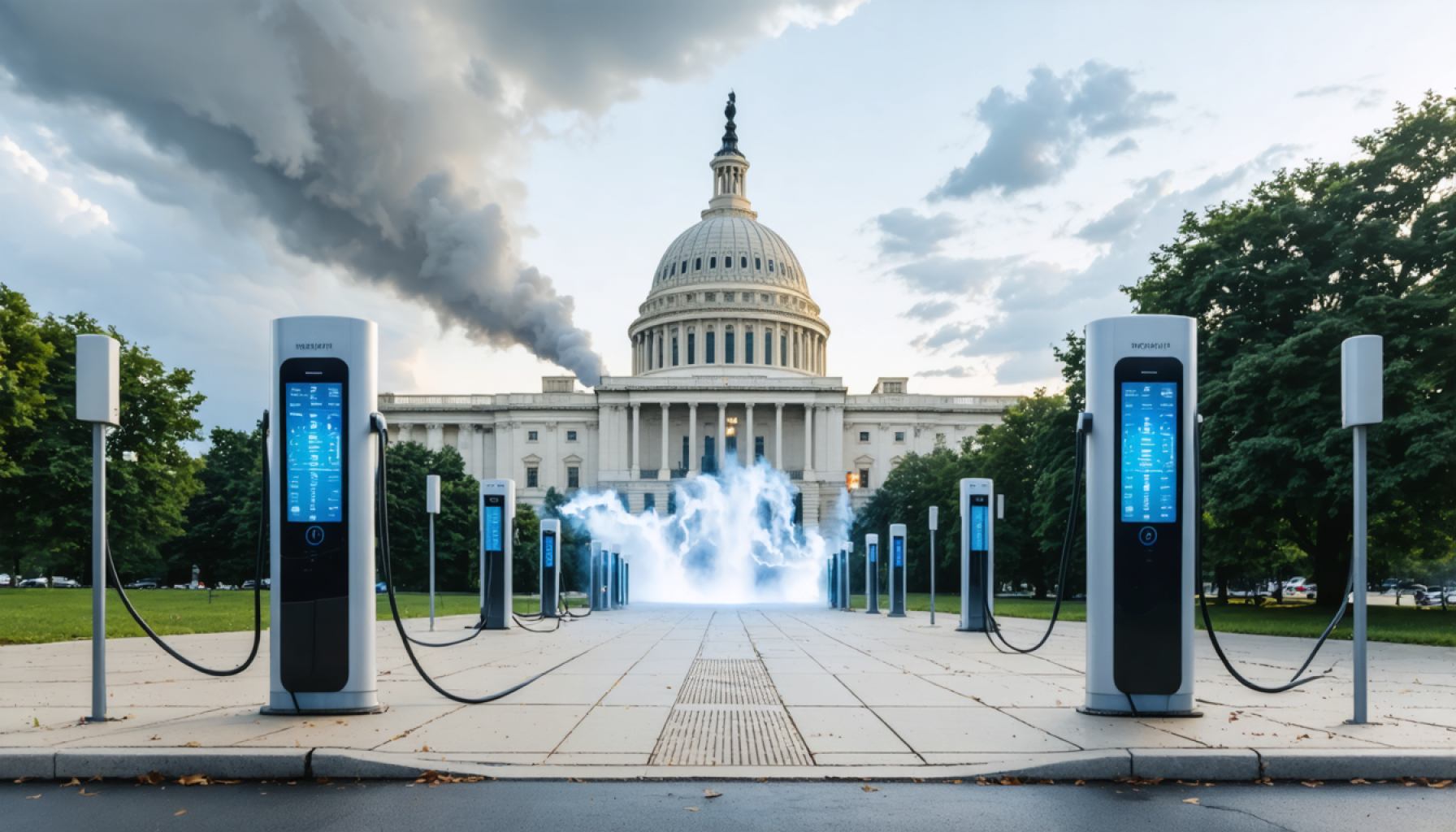- The General Services Administration (GSA) is set to disconnect its network of 8,000 electric vehicle chargers at U.S. federal buildings.
- This decision starts with the Denver Federal Center’s chargers, labeled as “not mission critical.”
- The move aligns with the current administration’s reduced support for renewable energy initiatives.
- Federal employees must find new solutions as the convenient charging infrastructure is phased out.
- The decision indicates the administration’s broader stance on energy policy, shifting away from sustainable investments.
- Renewable energy supporters within the federal workforce face challenges as green infrastructure support dwindles.
- This change poses broader questions about the future direction of national energy agendas in public sectors.
The quiet hum of electric vehicles charging at U.S. federal buildings is set to fall silent. The General Services Administration (GSA), the body responsible for managing federal buildings, prepares to disconnect its entire network of electric vehicle chargers, numbering in the hundreds with an impressive count of 8,000 plugs.
The corridors of the federal operations buzzed with discussions after internal communication indicated an imminent shutdown, beginning with the Denver Federal Center, where plugs are being deemed “not mission critical.” This move comes amid broader administrative strategies that slash federal support for renewable initiatives, resonating with the administration’s pivot away from such investments.
While office chatter turns to future transportation solutions, federal employees brace themselves for an era without access to the convenient charging infrastructure. This shutdown marks a significant shift in a previously rising trajectory towards sustainable energy within governmental operations.
Strikingly, this decision reflects a deeper narrative of the administration’s stance on energy policy, pulling the plug not only on chargers but also on financial support mechanisms that once fueled growth in renewable sectors. Workers accustomed to the quick, seamless access to power may find themselves looking for alternatives, as the electric vehicles parked outside federal offices suddenly seem like relics of a future deferred.
The implications for renewable energy enthusiasts in the federal workforce are clear—it’s a stark reminder of the tenuous balance between political will and environmental innovation. As the chargers power down, a larger question powers up: What is the future of green infrastructure in public sectors? In an era of vested interest and evolving policies, the chargers’ demise stands as a bellwether for the direction of national energy agendas.
The Silent Shift: What the Closure of EV Chargers at Federal Buildings Means for the Future
How-To Steps & Life Hacks
Navigating the transition away from readily available charging at federal buildings can be daunting, but there are practical steps and life hacks to ease the process:
1. Plan Alternative Charging: Utilize apps like PlugShare or ChargePoint to locate the nearest public EV charging stations.
2. Install Home Charging: Consider installing a Level 2 home charging station. Evaluate your home’s electrical capacity and consult with an electrician for installation.
3. Stay Informed: Join EV owner communities online for updates about public policy changes and for shared resources.
Real-World Use Cases
Federal employees using EVs primarily relied on workplace charging for convenience and cost savings. With these stations going offline:
– Home Charging Dependence: Owners will rely more on home charging, impacting electricity consumption and costs.
– Shift to Public Charge Networks: Increased usage of commercial charging stations may drive demand and development for more widespread infrastructure.
Market Forecasts & Industry Trends
The closure of federal EV charging does not reflect the general market trajectory. Globally, the EV market is accelerating:
– EV Sales Growth: According to Statista, electric vehicle sales worldwide are predicted to reach 10.7 million units by 2025.
– Infrastructure Expansion: The deployment of public chargers is expected to grow by 30% yearly to meet the rising demand.
Reviews & Comparisons
When considering alternatives to federal workplace charging, assess various charging apps and networks:
– ChargePoint vs. EVgo: ChargePoint offers a larger network and convenience with prevalent locations, while EVgo is lauded for fast-charging capabilities and user-friendly interfaces.
Controversies & Limitations
While the federal shutdown impacts individual users, it also highlights broader controversies:
– Political Influences: The decision underscores how shifting political priorities can significantly impact environmental progress.
– Infrastructure Costs: The cost of installing and maintaining charging stations remains a challenge for both public and private sectors.
Features, Specs & Pricing
For those considering installing home charging stations:
– Level 2 Chargers: Offer quicker charging times (4–5 hours for a full charge) but typically require professional installation.
– Pricing: On average, costs range from $500 to $700 for the unit, plus $1,200 to $2,000 for installation, depending on electrical panel upgrades.
Security & Sustainability
– Sustainability: EV adoption is a key component of reducing carbon footprints; hence, alternative charging solutions remain essential for sustainable commuting.
– Security: Home charging enhances personal security by reducing reliance on public infrastructure, which can be susceptible to disruptions.
Insights & Predictions
– Long-term Trends: Despite setbacks, long-term EV adoption will likely continue to grow, driven by global environmental goals and consumer demand.
– Policy Predictions: Expect more policy-driven support for renewable energy infrastructure as climate considerations gain traction.
Tutorials & Compatibility
For federal workers considering personal installations:
– DIY Installation Guides: Consult YouTube tutorials by certified electricians for deciding whether a DIY approach suits your skill level.
– Vehicle Compatibility: Ensure your EV model supports charging features before purchasing a home station.
Pros & Cons Overview
Pros:
– Reduced reliance on potentially disrupted federal service.
– Increased control over charging availability and costs.
Cons:
– Higher upfront costs for home systems.
– Potential inconvenience in transition periods.
Actionable Recommendations
– Monitor Policy Changes: Stay updated on federal energy policies; shifts could signal future sector trends.
– Network Utilization: Engage with local EV owner groups and networks to learn about emerging opportunities and charging options.
For more insights and updates on energy and policy trends, visit the Department of Energy website.














